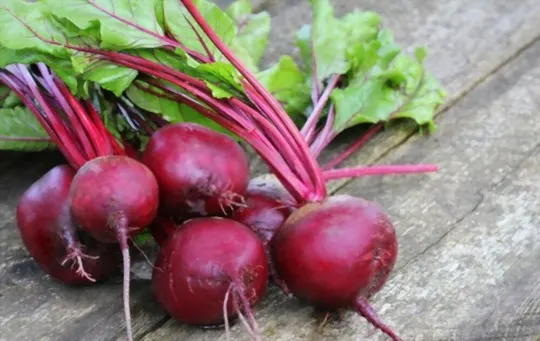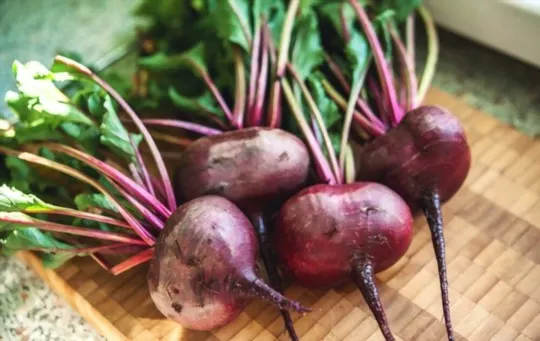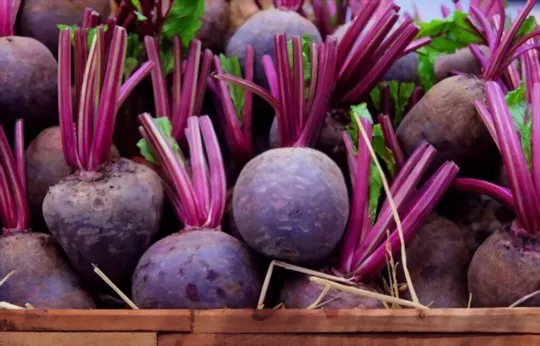If you’re anything like me, you’ve probably stumbled across a beetroot in the grocery store, looked at its vibrant deep purple hue and wondered – what does it taste like?
This comprehensive guide breaks down everything there is to know about the flavor of this healthy root veggie.
By the end of the post, no matter your previous feelings or experience with beetroots, you’ll have a better understanding of their distinct yet versatile taste.
Ready to get started? Let’s dive deep into learning all about beetroot flavors!
What is Beetroot?

Beetroot, also known as beets or garden beets, is a root vegetable that is typically deep red-purple in color.
It belongs to the same family as chard and spinach and can be consumed in various ways such as cooked, pickled, or raw.
Beetroot has a sweet and earthy flavor and is commonly used in salads, soups, smoothies, and even desserts.
Different varieties of beetroot exist around the world, with varying colors such as yellow or white.
Beetroot is also high in vitamins and minerals such as vitamin C, fiber, folate, iron, and potassium.
It has been increasingly popularized for its potential health benefits including improved blood pressure regulation and athletic performance.
Beetroot can typically be found year-round in grocery stores but can also be grown at home with proper care.
When selecting beetroot from the store or farmer’s market, choose ones that are firm to touch without any wrinkling or soft spots.
Store in the refrigerator until ready to use.
Overall, beetroot is a versatile root vegetable that adds sweetness and nutrition to many dishes.
Whether cooked or raw, it offers an earthy taste that pairs well with other ingredients like goat cheese or balsamic vinegar.
So give it a try next time you’re looking to add some variety to your meals.
What Does Beetroot Taste Like?

Beetroot has a unique taste that is quite different from other root vegetables.
The earthy and sweet taste can be described as distinctive, with a hint of bitterness.
Some people also report that the vegetable has a slightly nutty flavor to it.
The texture of beetroot can vary depending on how it is cooked.
When boiled or roasted, beetroot becomes tender and slightly soft, while when grated or raw, it offers a satisfying crunch alongside its rich flavor profile.
Beetroot’s sweetness comes from natural sugars found in the vegetable, which are also responsible for giving it its vibrant red color.
These sugars can make the taste of cooked beetroot feel mildly caramelized or almost fruity.
Contrary to popular belief, beetroot does not taste like dirt or soil.
Some people may find the earthy undertones of this root vegetable overpowering or unpleasant, but most describe it as deliciously complex and versatile in terms of its culinary applications.
Moving forward, we will discuss some of the factors that can affect the way beetroot tastes in cooking and eating, such as preparation methods and seasonality.
Factors that Affect the Taste of Beetroot
The taste of beetroot can vary depending on different factors, which include its variety, soil quality, climate, age, and cooking method.
Let us look at how each of these factors affects the flavor of beetroot.
- Variety: The type of beetroot used can have a significant impact on its taste. Some varieties are sweeter than others, while some have a more earthy flavor.
- Soil Quality: The quality of the soil in which beetroots are grown can affect their taste. Beets grown in fertile soil tend to be sweeter and less bitter.
- Climate: The weather and temperature during growth affect the sugar content of beetroots. Cooler temperatures produce sweeter beetroots while warmer temperatures make them less sweet.
- Age: Younger beetroots generally have a milder and sweeter taste compared to older ones which might have a stronger earthy taste.
- Cooking Method- The way you cook beetroot greatly impacts its flavour as it helps break down cellular walls releasing sugars thus enhancing sweetness. Boiling reduces sweetness but aid nutrients retention while roasting enhances the earthiness alongside nutrients retention.
The above said factors are interrelated; therefore, some discrepancies may arise depending on other external factors such as environmental changes that may occur during planting hence affecting nutrient absorption.
That being said, now you know why your mother’s homegrown beetroot tasted different from store-bought ones.
How to Cook Beetroot to Enhance its Flavor?

Cooking beetroot is one way to enhance its flavor and bring out its natural sweetness.
Here’s how you can do it in five simple steps:
- Wash and scrub the beetroot thoroughly under running water.
- Cut off the greens and tail from the beetroot before cooking.
- Boil the beetroot in salted water for about 45 minutes, or until it is tender when poked with a fork.
- Gently peel off the skin using your fingers while the beetroot is still warm.
- Cut the cooked beetroot into bite-sized cubes or slices, ready to be used in your favorite recipes.
When cooking beetroot to enhance its flavor, there are a few key things to keep in mind:
- Boiling is a great way to cook beetroots as this helps retain their natural color and flavor.
- Make sure to use plenty of water when boiling as this will help prevent the beetroots from losing their color or turning brown.
Additionally, it’s important to not overcook the beetroots as this can cause them to become mushy and lose their texture.
Keep an eye on them while cooking and check regularly by gently poking them with a fork.
By following these simple steps and tips, you can cook deliciously flavorful beetroot that’s perfect for adding to salads, soups, stews, sandwiches, and more.
In the next section, we’ll look at some of the culinary uses of beetroot that showcase its versatility in different cuisines.
Culinary Uses of Beetroot

Beetroot is a versatile root vegetable that can be used in a variety of dishes.
Here are some culinary uses of beetroot:
- Roasting: Roasting brings out the natural sweetness of beetroot. Coat thinly sliced beets with oil and roast them in the oven for a tender and flavorful side dish.
- Soup: Beetroot soup is not only delicious but also healthy. Combine pureed beets with broth, cream, and seasonings for a warming and nutritious soup.
- Salads: Beets add color and texture to salads. Try combining roasted beets with arugula, goat cheese, and walnuts for a refreshing salad.
- Pickling: Pickled beets are great as a side dish or topping for sandwiches. Simmer sliced beets in vinegar, sugar, and spices for a tangy and flavorful garnish.
- Juice: Beetroot juice has become popular due to its health benefits. Simply juice raw beetroot along with other fruits and vegetables for a nutrient-packed drink.
If you’re looking to spice up your meals, try incorporating beetroot into your dishes.
Where to Buy Beetroot and How to Store It?
When it comes to buying beetroots, you can find them in most grocery stores and supermarkets.
Look for beetroots that are firm and have a smooth texture.
Also, make sure they are free from any bruises or spots.
If possible, try to buy organic beetroots as they are less likely to contain harmful chemicals.
It is recommended to store the beets in your refrigerator, unwashed and with their leaves removed.
The leaves can be stored separately in a plastic bag with holes poked in it to release excess moisture.
Beetroots can last up to 2 weeks when properly refrigerated.
If you want to enjoy the health benefits of beetroot all year round, then consider buying canned or pickled beetroot.
These have longer shelf-lives than fresh ones and can also add an interesting twist to your recipes.
One thing you should keep in mind is that beets tend to stain everything they come into contact with.
So, when handling them, wear gloves or use a plastic bag as a makeshift glove.
This will prevent your hands and clothes from getting stained.
To sum up, beetroots are easily available at most supermarkets and grocery stores.
Look for firm ones free from bruises or spots while shopping for them.
Store them properly by keeping them unwashed in the refrigerator without their leaves, which need separate storage in a ventilated bag.
Lastly, consider canned or pickled beetroot if you want to use it all year round without worrying about freshness.
Conclusion
Beetroot is a nutritious vegetable that has been consumed for centuries.
It is packed with many health benefits such as improving blood circulation, supporting liver function, and promoting healthy digestion.
Its unique taste and vibrant color have made it a popular ingredient in many dishes around the world.
Overall, incorporating beetroot into your diet can provide numerous health benefits as well as add a unique flavor to your meals.
Whether you enjoy it raw in salads or roasted in oven-baked dishes, beetroot is a versatile and delicious vegetable that everyone should try at least once.

What Does Beetroot Taste Like? A Comprehensive Guide
Ingredients
- Beetroot
- Ingredients from your selected recipes
Instructions
- Select ingredients that work well together.
- Use a recipe or method that will enhance their natural taste.
- Taste and adjust the recipe as needed to achieve the desired flavor.

Carrie is a food writer and editor with more than 15 years of experience. She has worked for some of the biggest names in the food industry, including Bon Appétit, Food & Wine, and Martha Stewart Living.
As the Editor in Chief of IntroChicago.com, Carrie oversees all of the content on the site. She also manages the team of contributing writers and editors, who help to create delicious recipes, helpful tips, and informative articles that you’ll find on the site.
A native of the Chicago area, Carrie is passionate about all things food. She loves trying new restaurants and experimenting with new recipes in her kitchen. She’s also a graduate of the Culinary Institute of America, so she knows a thing or two about food!
